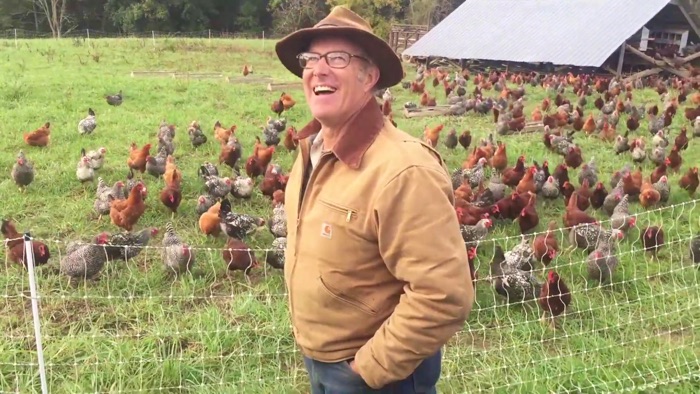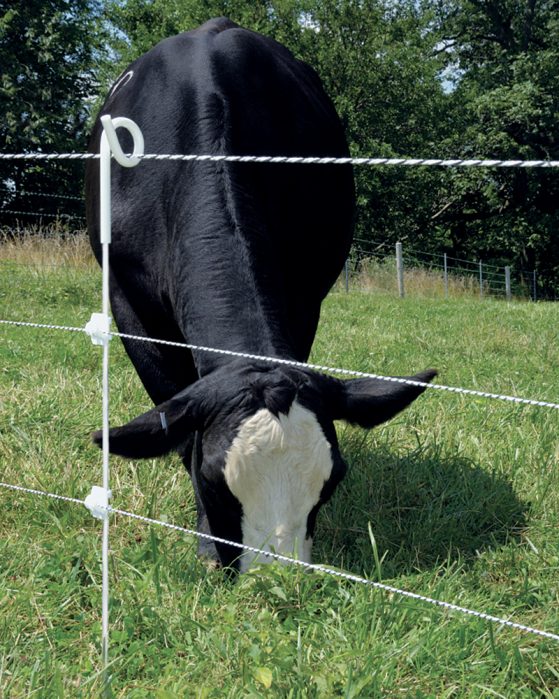Rotational Grazing for Pastured Livestock
By Joel Salatin
The secret to forage management is to keep your critters moving. Follow these rotational grazing guidelines for your pastured livestock.
Few things make my head explode faster than visiting a small farm and seeing a stationary chicken house surrounded by bare soil. No matter how small, the stereotypical yard with chickens scratching around in bare dirt is unhealthy. Removing the soil’s vegetative cover makes it vulnerable to erosion and shuts down biological activity. That activity is important because the work of that community of beings, from earthworms to mycorrhizal fungi, prevents harmful pathogens from gaining the upper hand. A healthy, vegetation-covered, biologically active soil ensures plenty of the good bugs.

If you have a chicken yard the size of a postage stamp, covering the soil with wood chips, leaves, straw or compost will ameliorate the lack of vegetation and create a living medium even without green, growing plants. Chicken traffic in and out of a coop creates a high-impact zone and, even in totally free-range situations, will cause barrenness over time.
I saw an interesting solution in Canada, where a fellow put 2-by-4s edgewise on the ground about a foot apart, extending about 12 feet from the chicken house. He spread sturdy wire mesh — large enough for the chickens’ waste to pass through but small enough not to trap their feet — over these boards set on their edges. The eaves of the house drip dew and rainwater on this high-traffic zone, where the chickens concentrate manure. (They like to poop as they enter and exit their quarters.) Luxuriant green grass grows up through the wire mesh and the chickens keep it mowed perfectly. What would otherwise be a toxic, pathogen-friendly, poopy mess is now a productive “salad bar” that looks like a beautiful green carpet. Separating the chickens from the ground by a mere 4 inches completely changed the hygiene of the environment — actually building soil instead of letting it erode. Very cool.
Prevent the ‘Second Bite’
Of course, any chicken run larger than a postage stamp can enjoy a composting yard (lots of carbon bedding to cover the soil and let the chickens stir), or a portable structure that allows the birds to graze on fresh pasture continually. Whether you make or buy such a portable shelter, leaving the birds in one place for only a day will protect the surrounding vegetation and stimulate greater growth. The chickens will enjoy the benefits of eating fresh green material without destroying plants or soil.

As with a mowed lawn, the pruned vegetation will grow back quickly as soon as it has rested. Quick pruning followed by long rest periods will stimulate more biomass production than would occur in a static state. Even better than a lawn mower, the chickens leave behind fertilizer that will encourage the vegetation’s regrowth — winner, winner, chickens’ dinner! With larger flocks, employing lightweight, electric poultry netting will create the same win-win portability.
The secret to forage management is pruning and then allowing the vegetation to rest. Continuous animal access to any one place will eventually diminish forage production of the plants the animals like best. All animals have a palatability index — they, too, like their ice cream better than their spinach.
Many people with a 1-acre lot and one dairy cow ask, “Do I really need to rotate my cow?” The answer is, “Yes!” The first day the cow is on that 1-acre lot, she’ll eat the most palatable, delectable plants out there. As soon as those newly sprouted plants grow back enough for her mouth to grab, she’ll go for them again. The goal of proper forage management is to protect plants from that second graze through her salad-bar favorites.
After being pruned, plants need enough time to go through their growth curve — slow start, rapid acceleration, and then a senescent slow down as the plants mature. If your cow continuously grazes the same area, eventually the plants she likes will weaken and those she doesn’t like will take over. When we domesticate animals on defined property, our responsibility is to figure out how to mimic the way migratory flocks and herds interact with the landscape. André Voisin, godfather of managed grazing, called this “the law of the second bite.” In rotational grazing, you must delay that second bite until the good forage has recovered sufficiently to regenerate, a period that will vary with the forage. Regardless of animal type, plant variety or the area’s climate, the diversity of vegetation decreases in any area that’s continuously grazed. This is why strategic timing is such a key to successful forage management.
Managed Grazing for the Micro-farmer

The pasture plan for one milk cow would simply be to offer a tiny new paddock — maybe only 5 yards by 10 yards (50 square yards) — every day. If you have 1 acre, you could offer almost 100 of these daily paddocks. That would provide about 99 days of rest for each paddock between grazing times. The best forage plants and the rest periods will change based on day length and climate — weather conditions, rainfall and temperature. Fertility and type of vegetation will also play a role.
If your cow needs 50 square yards a day and you want to move her just once a week, she’d get a 350-square-yard paddock. Fast-growing grass could be tall enough to graze again in just two days, but that wouldn’t be enough time for the plant to replenish the carbohydrates it needs to send forth new shoots and deeper roots. So even though less-frequent moves might seem more convenient, you won’t get as much benefit as you would with shorter stays on smaller paddocks.
The paddocks don’t need to be permanently fenced, but can be staked out as you move the animal around the pasture area. A portable electric fence is the high-tech “Aha!” of rotational grazing that enables the grazier to adjust the paddock barriers as forage volume and grazing requirements change.
Your bottom line should be to protect the forage from the second bite by allowing it a period of rest and fast regrowth immediately after the first bite. The result will be far more forage production, far more solar energy converted into biomass, more forage diversity, and more soil organic matter developed through larger root mass — which, by the way, removes carbon dioxide from the atmosphere and stores it in the soil. Plus, you get healthier animals and nutrient-rich meat and dairy products.
Custom Water and Shade
Managing rotational grazing requires portable water and, usually, portable shade. For example, a water line supplying a tub with a float valve is cheap and worth the investment. Simple, portable “shademobiles” you can make using greenhouse shade cloth will keep the animals away from trees (another high-impact zone, with bare soil and pathogen incubation) and will spread their droppings where the vegetation can metabolize this ecological gold. You’ll want to customize both shade and water, depending on your circumstances and the season, and can find good advice online about how to do so, such as on the National Sustainable Agriculture Information Service’s website.
Farmers now have access to inexpensive, lightweight, portable electric fencing as well as shelters and watering methods that enable us, for the first time in history, to duplicate domestically what occurs in the migratory-herds-on-prairie ecosystem that has worked well for countless centuries. What an incredible time to be alive! Exercising this level of management and care may sound arduous, but when you consider animal health, soil fertility, overall pasture productivity, human nutrition and even climate change, the dividends are clearly worth every bit of effort.
Now get ’em movin’.

Polyface Farm
Follow Joel’s blog musings at thelunaticfarmer.com.

